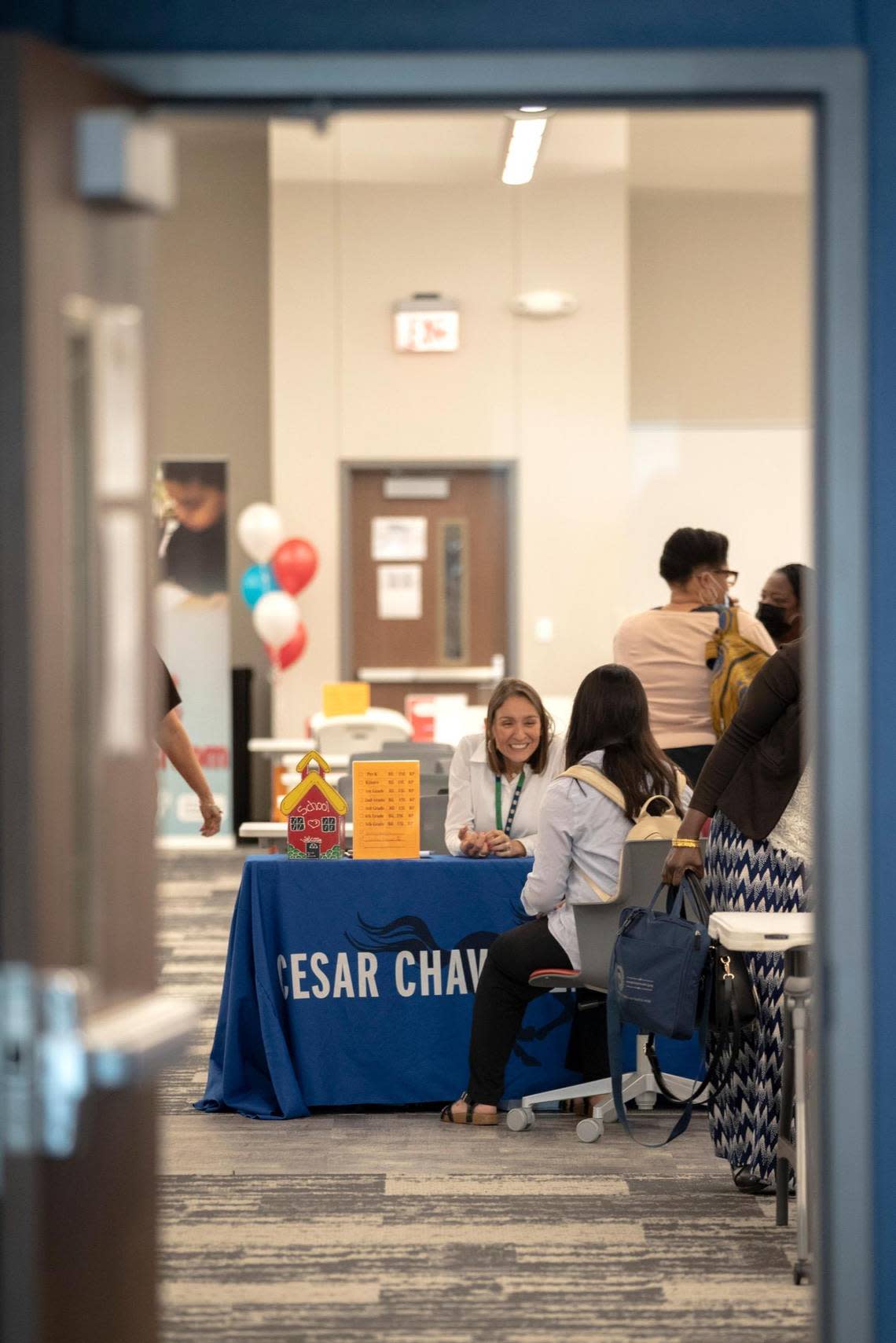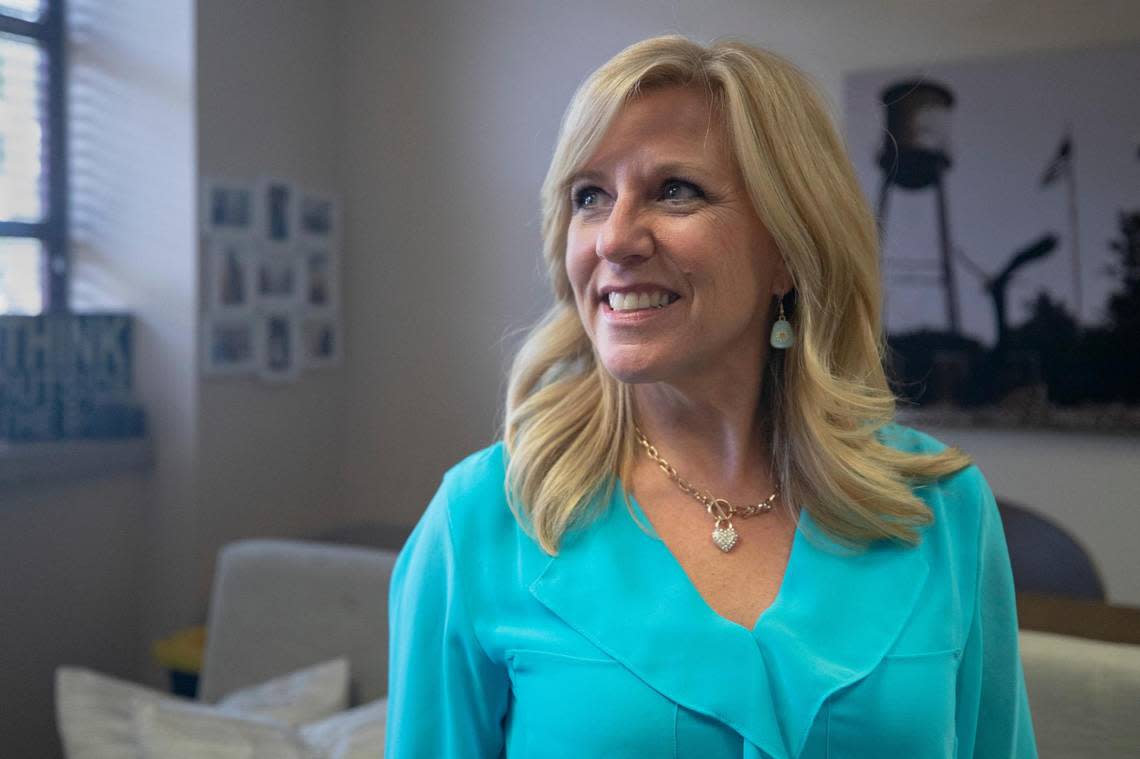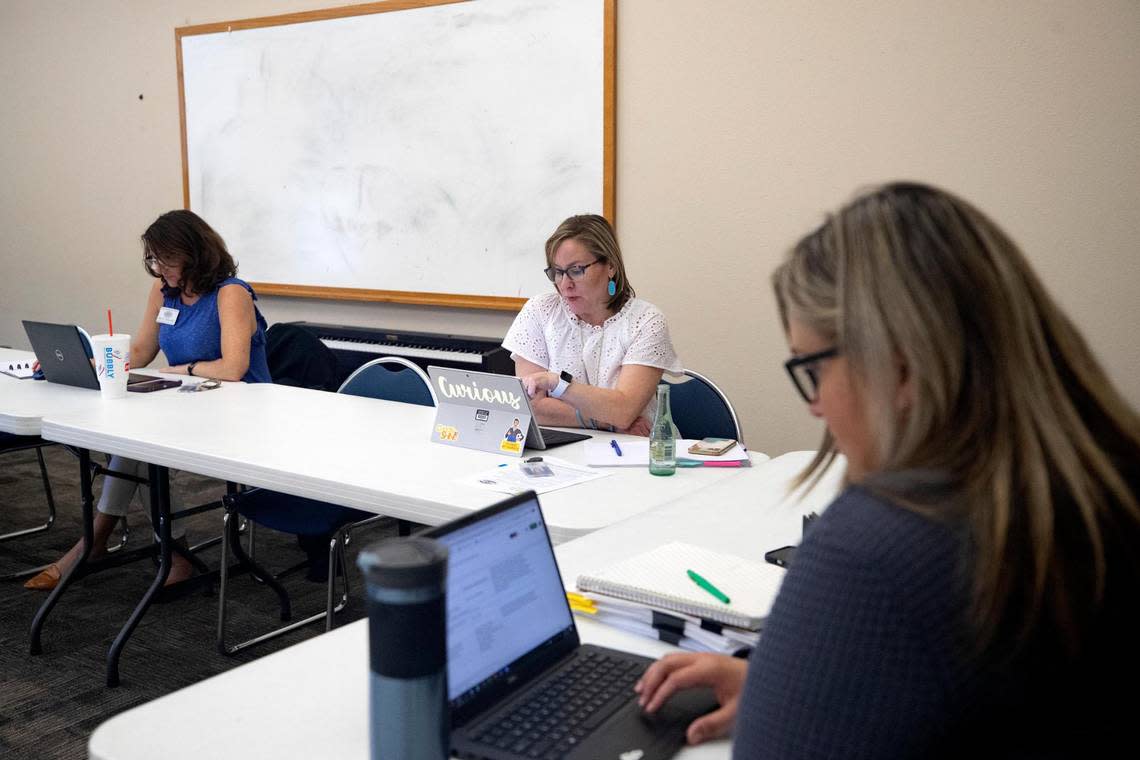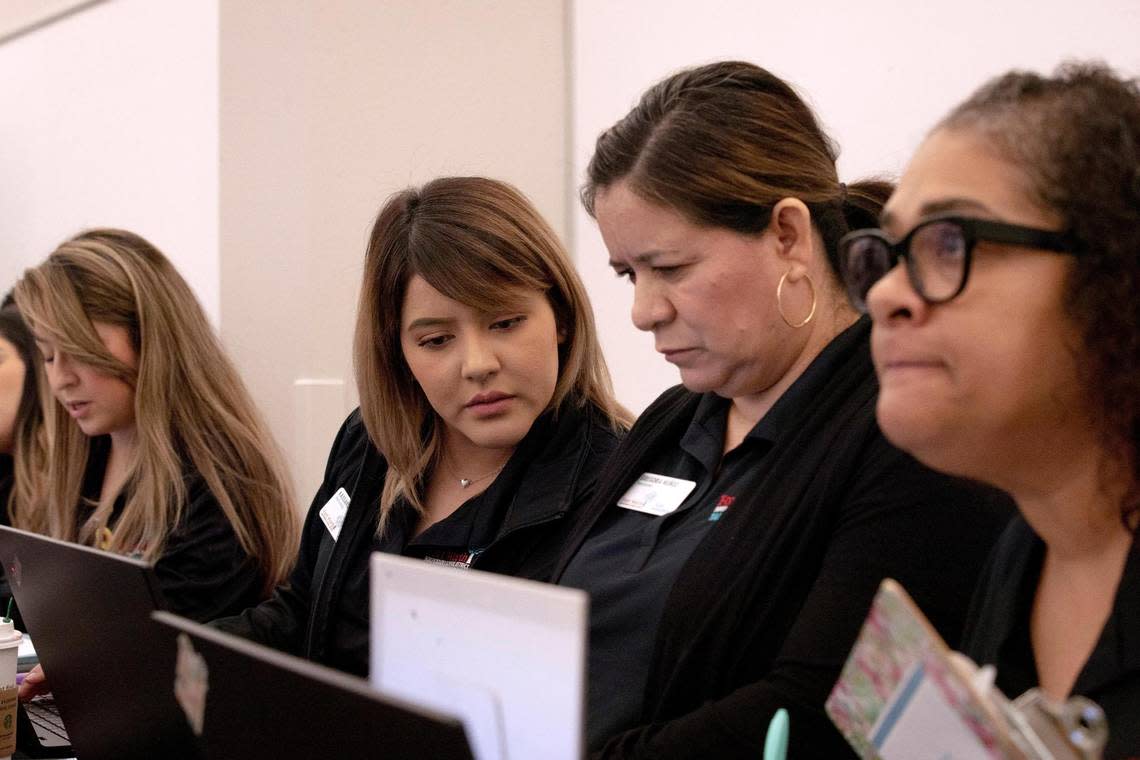‘Crisis that’s turned into catastrophe’: Fort Worth schools grapple with teacher shortage
Shaquila Anderson has known she wanted to be a teacher since she was a child in suburban Tulsa.
Anderson’s fourth-grade teacher was an important mentor in her life, she said. She showed Anderson how to work for things she wanted, and told her that she could be anything she wanted to be. Anderson knew she wanted to grow up to be just like her, she said.
In August, Anderson, a recent graduate from Oklahoma State University, will be a third-grade teacher at Bill J. Elliott Elementary School in Fort Worth. She’s most excited about forming the same kinds of relationships with her students that were so important to her when she was in school.

But Anderson, 25, is clear-eyed about the job ahead of her. She comes into the teaching profession at a time when many educators are leaving due to challenges brought about by the COVID-19 pandemic, among other issues, creating a severe teacher shortage not only in the Fort Worth school district, but also nationwide.
During her student teaching last year, Anderson got a chance to see how much teaching had changed from how she pictured it. It was a difficult realization, she said.
“I kind of had a moment where I was excited because I’m finally doing something I’ve always wanted to do,” Anderson said. “But at the same time, I was kind of sad, because the teaching world isn’t the same that I thought it would be.”
Since the beginning of the COVID-19 pandemic, Fort Worth teachers have been stretched even thinner than usual. Staffing shortages have left teachers scrambling to cover classes for absent colleagues, even as they struggle to help their own students catch up from pandemic-related learning loss. But there are signs those staffing challenges could be even greater this year: By July 1, Fort Worth ISD’s deadline for resignations, the district saw a 50% uptick in teacher resignations over the previous year. With the beginning of the next school year approaching, district officials are stepping up efforts to recruit new teachers to replace those who have left the classroom in large numbers over the past two years.

But experts say the national teacher shortage stems from issues that date back decades, many of which the pandemic exacerbated but didn’t create. Researchers say there are steps states and local school districts can take to support teachers and keep them from leaving the classroom, and also to shore up their pipelines of new teachers entering the profession.
As a third-grade teacher, Anderson will be meeting her students at a critical time in their lives. Educational leaders often say that third grade is the point at which students stop learning to read and begin reading to learn. Researchers say that students who can’t read proficiently by the end of third grade face daunting challenges for the rest of their educational careers.
Anderson knows most of her students won’t be at the point where they need to be academically. Students nationwide, including in Fort Worth, lost a great deal of ground during school shutdowns and the shift to online learning. Anderson said she’s prepared to work with students to figure out where they are and help them close any gaps in their learning. Those gaps need to be the first priority, she said, because students may not be able to move on to more advanced concepts if they haven’t mastered the foundational skills first.
“If I go in and we’re talking about addition, and my students don’t even have the prior knowledge of numbers, how can I teach them addition?” she said.
Fort Worth sees uptick in staff resignations
The Fort Worth school district’s first day of school is Aug. 15. By July 1, which marked Fort Worth ISD’s deadline to resign, the district had received 1,084 resignations from teachers. That’s a 50% increase over the 722 resignations the district received by the same point last year.
Those resignations come after a year when the district — along with others in Tarrant County — already struggled to keep a teacher in every classroom. Because of a shortage of substitute teachers, principals drafted librarians, counselors and instructional coaches to cover classes for teachers who were absent. Other times, they asked teachers to double up classes or even called in central office staff to help.
Raul Peña, Fort Worth ISD’s chief talent officer, said none of those solutions is ideal. Every time a principal has to send a librarian to cover a class or ask a teacher to double up, it represents a disruption in those students’ educations, he said.
Peña said the district began recruiting new teachers earlier than usual this year. Aggressive recruiting efforts typically don’t begin until late spring, he said. This year, they began in January.

The district also offered a package of sign-on bonuses designed to get new teachers in the door, including a $1,000 bonus for all new teachers who begin work this year, a $2,000 early signing bonus for those who signed a letter of intent by May 1 and a $500 “welcome home” incentive for new teachers who are graduates of a Fort Worth ISD high school.
One other piece of the district’s strategy is working with current employees who have a college degree but no teaching certificate to get them certified to teach, Peña said. District leaders identified teaching assistants and paraprofessionals in the district who could go to work as teachers quickly once they were certified.
The district offered them a deal: Fort Worth ISD would pay to get them certified through the Region 11 Education Service Center. In return, those teachers would agree to remain in Fort Worth ISD for three years. The first cohort of 16 participants began the program earlier this year. The program focuses on getting teachers into the district’s highest-need areas: elementary ESL and bilingual, secondary science, math, English language arts and reading, as well as special education, Peña said.
Texas’ teacher colleges struggle to meet demand
Although the teacher shortage has become more acute and more visible as a result of the pandemic, experts say it’s been brewing for years. Even during normal times, large numbers of teachers leave the profession each year, and traditional teacher training programs struggle to turn out enough graduates to replace them.
“It’s sort of like a crisis that’s turned into a catastrophe,” said Charles Martinez, dean of the College of Education at the University of Texas at Austin.
In the decade before the pandemic, roughly 10% of Texas’ teachers left the workforce each year, according to figures from the Texas Education Agency. Texas isn’t far out of line with national trends: 8% of teachers nationwide leave the profession annually, according to the National Center for Education statistics.
That may not be a huge attrition rate, but in states like Texas, which employs between 350,000 and 375,000 teachers each year, it means schools must replace about 35,000 educators annually. That problem is a hard one to grapple with, Martinez said. The state’s colleges of education don’t have the capacity to turn out that many new teachers each year, he said. Only about 9,000 of the state’s new teachers in the 2020-21 school year came from a traditional four-year program.
The number of new teachers the state gets from four-year colleges of education has been declining for years, according to TEA. At the same time, a large and growing share of the state’s teacher workforce is made up of career changers who got their teaching certificates through alternative certification programs. While those programs send thousands of teachers into Texas classrooms each year, many of those teachers don’t stay there for long.
During a presentation to the Texas Senate Education Committee in May, state Education Commissioner Mike Morath told lawmakers that new teachers who are certified through alternative certification programs leave the profession after only a few years of teaching at a higher rate than those who come from four-year programs. If alternatively certified teachers left the classroom at the same rate as those from traditional programs, the state would have to recruit about 4,000 fewer new teachers each year, he said.
Martinez said he thinks part of the problem is the devaluing of teaching as a profession. Many of his students tell him that people around them wonder why, if they’re smart enough to get into UT Austin, they wouldn’t choose a profession that pays better than teaching.
Another problem, Martinez said, is that career changers who are looking to go into teaching typically want a program that gets them into the classroom quickly. For most, that means an alternative certification program. Some of those programs are high quality, he said, but others aren’t. The state’s traditional teacher preparation programs could provide that same service, he said, but they haven’t done a good job of meeting those students’ needs.
Most of those career changers already have bachelor’s degrees in something other than education. Colleges and universities tend to treat all students who already have bachelor’s degrees as graduate students, Martinez said. But most students who are looking to become teachers after a career of doing something else aren’t looking for master’s degrees, he said. They only want a teaching certificate. Traditional colleges of education need to find better ways of working with those students, Martinez said.
Keller ISD sees fewer candidates for teacher jobs
Tracy Johnson, the chief human resources officer for the Keller Independent School District, said more teachers in the district resigned this summer than any previous summer in the past five years. In a typical year, Keller would need to replace about 350 professional staff, including teachers, librarians and instructional coaches, she said. This year, the district will have to replace at least 500 professional staff members.
The district typically doesn’t have much trouble finding the candidates it needs to fill all of its vacant positions, Johnson said, and she isn’t overly worried about whether it will be able to do so this year, either. But she’s noticed there are fewer candidates to choose from this year.

With declining enrollment in the state’s teacher preparation programs, district leaders have worried for at least the past five years that the teacher shortage was coming, Johnson said. But the effects of the pandemic have made matters worse, she said.
Many teachers walked into the 2021-22 school year feeling optimistic, Johnson said. They thought the worst of the pandemic was behind them, and they’d be able to get back to normal.
But that wasn’t the case, Johnson said. School shutdowns and other educational disruptions had left students with wide gaps in their learning, and the job of helping them catch up left teachers feeling overwhelmed, she said. A labor shortage in nearly every sector of the economy left teachers who wanted to leave the profession with plenty of other options, she said.
Early in the spring, the Keller ISD Board of Trustees approved a compensation package that included a $59,000 a year salary for first-year teachers. That’s $3,000 more than the district offered first-year teachers last year. The fact that the board approved pay levels relatively early in the year helps the district retain current teachers and attract candidates who may have been on the fence about whether to go to Keller, Johnson said.

Johnson said she thinks it’s important that teachers understand their value in their communities. She also thinks that communities can do more to make their teachers feel valued.
“I always tell our teachers, you are the teachers of all professions,” she said. “If they’re not coming through you, then they’re not able to move on to be future teachers, welders, doctors, lawyers, bankers, reporters, administrators, entrepreneurs. I mean, it all starts with the education that our educators provide.”
Elsewhere in Texas, rural school districts that struggle to offer salaries to compete with larger school districts are finding creative ways to attract teacher candidates. Several rural school districts across the state, including Mineral Wells, Chico and Jasper, have shifted to a four-day school week in hopes of attracting teachers looking for more flexibility. Some districts add hours to the school day to make up for the extra day off, and others lengthen their school years.
Teaching during COVID-19 was ‘a learning experience’
Science teacher Lauren Begnaud is one of hundreds of new teachers coming into Fort Worth ISD in the fall. Begnaud will be starting work at the I.M. Terrell Academy for STEM and Visual Performing Arts when school resumes in August. She comes to Fort Worth ISD after spending two years teaching at a charter school in Dallas. Begnaud was in her first year of teaching in 2020, when the pandemic arrived in North Texas and school buildings shut down.
“It was definitely a learning experience,” she said.
Begnaud finished college during the pandemic, which meant she was trained on how to handle online instruction before she entered the workforce. She did part of her student teaching in person before the pandemic reached Texas and schools shut down. That experience gave her an advantage, in a way, she said, because she was better prepared for the environment she’d be working in than some of her colleagues were.
Last year, Begnaud knew many of her students were having a hard time at home. Students suffered trauma during the pandemic. Some lost family members, and others lived in households where someone lost a job. Many of those students had a hard time finding the motivation to do schoolwork with all their challenges at home, she said. She found it most helpful to try to be a joyful, trustworthy adult in those students’ lives.
Begnaud didn’t always want to be a teacher. She had a love for science that initially took her toward a career as a doctor. But after realizing that she didn’t have the personality for it, she did some career searching and eventually found her way into education during her senior year in college. Despite the challenges of the past two years, Begnaud said, she can see herself teaching until she retires.
“I think I’m where I’m supposed to be,” she said.
Survey: Teachers experience high levels of job-related stress
A survey released June 15 by the Rand Corporation suggests that American teachers and school principals are experiencing job-related stress at more than twice the rate of the general adult population. Nearly three-quarters of the teachers and 85% of principals surveyed reported experiencing frequent job-related stress, compared to 35% of the general working adult population. Of the teachers surveyed, 59% reported feeling symptoms of burnout.
Well-being was even worse among Hispanic teachers, mid-career teachers and female teachers and principals, according to the survey. Teachers and principals of color reported similar sources of stress to their white colleagues, with the addition of racial discrimination alongside those stressors. Nearly half of principals and one-third of teachers of color reported experiencing racial discrimination, often from family members of their students or from their colleagues.
About a third of teachers and principals surveyed said they were likely to leave their jobs at the end of the school year. Teachers and principals who said they worked in a supportive school environment were least likely to leave their jobs.
Sy Doan, a researcher with the Rand Corporation, said reported plans to leave don’t necessarily translate into actual resignations — if a third of the nation’s teaching workforce left their jobs at the end of the year, that would be record-high turnover, he said. He also noted that researchers fielded the survey in January, at the height of the omicron surge. As the surge ebbed and fears of the virus began to wane, some teachers and principals who had planned to leave may have changed their minds, he said.
Still, Doan said the fact that so many teachers and principals told researchers that they wanted to leave their jobs should be a source of concern, even if most of them end up staying. It’s one more indication that many teachers and principals feel that the negatives of their jobs outweigh the positives, he said.
Staffing issues represented one of the most common sources of stress teachers and principals reported on the survey. For principals, staffing shortages left them scrambling to make sure every class was covered. For teachers, it often meant taking on extra students to cover for absent colleagues. What’s worrisome, Doan said, is that stress from staffing issues could begin to compound on itself: as more teachers leave the classroom because of burnout, staffing issues are only likely to get worse.

Researchers asked teachers and principals about mental health support in their districts. They defined those supports broadly — “these could be employee assistance programs, and these could be yoga sessions or something like that,” Doan said. Many teachers and principals said their districts had implemented those kinds of supports.
That’s a good sign, because it means those districts are taking their employees’ needs seriously, he said. But many teachers said the added responsibilities of the past year left them without the time or energy to take advantage of those supports, he said. Many other teachers said those mental health supports weren’t well targeted at the specific sources of stress that caused them the most problems.
As part of the study, researchers recommended that districts offer support to help teachers deal with job-related stress. But Doan said that it’s important that district leaders communicate with teachers and principals to find out what they need most and what kinds of support would be most helpful.
Discipline issues were overwhelming, says former Fort Worth ISD teacher
Trachelle Harston-Dearmore, a former pre-K teacher at Lowery Road Elementary School in Fort Worth ISD, retired at the end of last school year after a 28-year teaching career. Harston-Dearmore said she’d initially planned to teach five or 10 more years. But eventually, the job became overwhelming.
Classroom discipline issues seemed out of control, she said. She’d never had trouble with discipline problems in years past, she said, but she thinks student behavior has gotten worse recently. Students come into pre-K using swear words, she said. Last year, a kindergartener in her building soundly dressed down a teacher who confiscated the student’s vape pen, she said.
“Why does the kindergartener have a vape pen?” Harston-Dearmore said. “But the kid called her every name in the book.”
Harston-Dearmore said she also doesn’t feel like the district’s central office supports teachers. A pay raise would help, she said. Most teachers pay for classroom materials out of their own pockets, she said. During STAAR testing, when her building didn’t have the bandwidth to do anything online other than administer the tests, she spent $35 on a DVD player so she could show her students a video in class. That may not seem like much, she said, but when teachers spend $20 or $30 a week on their classrooms, it adds up.
Harston-Dearmore said she’d brought those issues up with administrators, but to no avail. After a while, she didn’t feel like she could stay.
“I don’t want anybody to think I’m disgruntled. I enjoyed my time in Fort Worth ISD. I liked my principal. She really did try to help,” she said. “I just feel like they need to be more responsive to the teachers and helpful to the teachers, rather than keep piling stuff on.”
Former teacher says policies kept teachers from holding students accountable
Stacy Bogle, a recently retired English teacher at Arlington Heights High School, said some of the district’s policies made it difficult for teachers to hold students accountable. For example, students are supposed to lose credit when they log more than a certain number of absences. But those students can come to school on Saturdays or before or after school on designated days and make up those absences. The policy allows students to avoid the consequences of being out of school, and it allows the district to avoid losing state funding because of those absences. But it doesn’t replace the direct instruction they missed from their teachers while they weren’t in class, Bogle said.
Students with even larger numbers of absences can appeal to have their absences forgiven. While serving on the committee that heard those appeals, Bogle saw students have as many as 100 absences erased. When school buildings reopened and students and teachers returned in person, administrators told teachers to approach everything with grace, Bogle said. But as a part of that, schools felt pressure from the district’s central office to wipe students’ slates clean at the end of the year, she said.
“We’ve caved to the point that there’s no recovery,” she said. ”There’s no coming back from that.”
Fort Worth principal casts wide net for new teachers
Monica Ordaz, principal at Fort Worth ISD’s Cesar Chavez Elementary School, said she got an earlier start on the hiring process than usual this year. In a typical year, she’d begin looking at applications for new teachers in March or April, she said. This year, she began in January. She also cast a wider net than usual, she said. She looked at several candidates from outside of Texas, and eventually hired three: one from North Carolina, one from Louisiana and one from Tennessee, she said.
Ordaz said she also turned to another source to find new teachers that she rarely uses: internal transfers from within the district. The district keeps a list of current teachers who are looking to transfer to another campus. Earlier this year, Ordaz hired a few bilingual teachers from the list.
She doesn’t like hiring transfer teachers from other schools because she knows it doesn’t solve the teacher shortage problem. It simply moves it around. But this year, she didn’t have many options. She felt she had to look out for her own school and her own students first, she said.

“I kind of feel like we’re taking from other principals, from other schools,” she said. “But that’s kind of the position that we’re in.”
On June 14, Ordaz only needed one more special education teacher to round out her roster. She knew many of her colleagues were still five or six teachers short of a full staff.
The staffing shortage was a major source of stress for teachers last year, Ordaz said. When a teacher was out sick or had to quarantine after being exposed to COVID-19 and Ordaz couldn’t find a substitute to cover the class, she often had to ask another teacher to double up, or ask staff members like counselors, librarians and coaches to rotate through the class until the teacher returned. That created a heavy load for teachers, she said, and it wasn’t ideal for students, either.
“That is actually a huge challenge,” Ordaz said. “Every day that there’s no teacher there, I know that kids are not getting the type of instruction that they really should be getting.”
